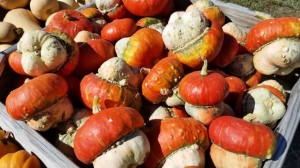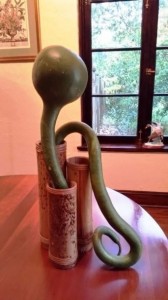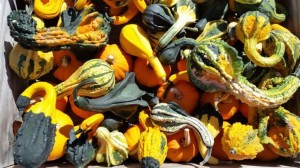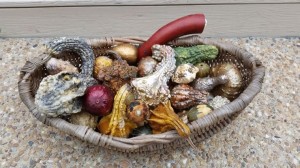Gourdgeous Gourds!
by Lynn Kirk, Public Relations Writer, Lewis Ginter Botanical Garden, reprinted with permission from the Richmond Times-Dispatch

The beauty and variety of gourds entice buyers to Steve Gallmeyer’s gourd and pumpkin stand in eastern Henrico.
Quirky, captivating and motley colored, the hard-shelled gourd (Lagenaria) is no longer limited as Thanksgiving décor. During December, ornamental gourds add distinctive flair to traditional holiday décor.
“They’re pretty if sprayed metallic silver, gold or copper blends and placed in crystal bowls or used as tree ornaments,” said Richmonder Lu Cavallaro, who serves as president of the Thomas Jefferson Garden Club. “There’s a big market for ornamental gourds each season because they make such beautiful, magical designs.”
Ornamental gourds claim the spotlight through yet another rising trend — as artistic focal points in modern centerpieces and floral designs.
Cavallaro, who trained as a master gardener, became intrigued with gourds more than 20 years ago. Since 2007, she has lectured about the topic at garden clubs across the region, encouraging gardeners and designers to experiment with the endless possibilities of design.

A dried gourd arrangement, such as this one by Lu Cavallaro, exudes an organic feel and serves as a conversation piece for year-round display.
“Gourds have a life of their own,” Cavallaro said. “They’re fascinating and different, and the variety is amazing.”
Gourds’ common names typically describe their natural shape at maturity — the snake, bottle, apple and swan gourds. Growers also master techniques that contort gourds even beyond nature’s imaginative ways.
The flexible, though fragile, young vines and fruits can be trained to bend, weave and loop as they grow. They also can be gently tied to trellises in unusual patterns or gingerly wound around braided ropes to create wavy-patterned growth.
“It takes a lot of love and time to manipulate the different shapes, but the more undulating the gourds are, the more fascinating they are,” Cavallaro said.
Artistic floral designers position dried gourds alongside traditional plant material. Structural elements, like driftwood or small branches of willow and Harry Lauder’s Walking Stick, add drama.
“Winning blue ribbons validates that gourds can take an arrangement from simplicity to magnificent,” Cavallaro said.
When Cavallaro started her journey with gourds, she initially was disappointed that they lasted only one season. Through research, she discovered how to properly dry them. “Hard-shelled gourds can last forever,” she said. “I have boxes of gourds that are 15 years old.”

The beauty and variety of gourds entice buyers to Steve Gallmeyer’s gourd and pumpkin stand in eastern Henrico.
Total drying time ranges from one to eight months, depending on the curing method and the gourd’s size. Some growers leave gourds in the field to dry over winter; others pick them after the vines have died and dry them atop outdoor trellises and pallets.
Weather, fungus and wildlife can take a toll, so indoor curing is another option.
One note of caution: Mold doesn’t necessarily indicate the gourd has rotted. Gourds have high water content, so as water exits the outer skin during the drying process, it creates moist conditions ideal for mold. Constant air circulation and storage in a low-humidity area can help reduce mold growth.

Richmonder Lu Cavallaro’s award-winning gourd arrangements are inspired by the contorted shapes she discovers.
Before use, gourds should be soaked in soapy water, the mold briskly scraped off with a stainless-steel scrubber and the shell thoroughly rinsed and dried. If the inner seed membrane is removed, the seeds can be sorted out, cleaned and saved for planting.
Editor’s Note: This article first published in the Richmond Times-Dispatch, in November 2014.
